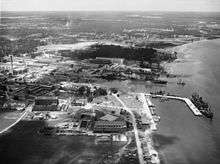Charleston Naval Shipyard
| Charleston Naval Shipyard | |
|---|---|
| North Charleston, South Carolina | |
| Coordinates | 32°51′47″N 79°57′59″W / 32.86306°N 79.96639°WCoordinates: 32°51′47″N 79°57′59″W / 32.86306°N 79.96639°W |
| Type | Shipyard |
| Site information | |
| Controlled by | United States Navy |
| Site history | |
| Built | 1909 |
| In use | 1901 — 1996 - now as Detyens Shipyards |
| Battles/wars | |
|
Charleston Navy Yard Historic District | |
  | |
| Location | Roughly bounded by First St., Hobson Ave., Avenue D, Fourth and Fifth Sts., and the drydocks bet. First and Thirteenth S, North Charleston, South Carolina |
| Coordinates | 32°51′38″N 79°57′53″W / 32.86056°N 79.96472°W |
| Area | 145 acres (59 ha) |
| Built | 1903 |
| Architect | multiple |
| Architectural style | Late 19th And 20th Century Revivals, Modern Movement |
| NRHP Reference # | 06000699[1] |
| Added to NRHP | August 09, 2006 |
Charleston Naval Shipyard (formerly known as the Charleston Navy Yard) was a U.S. Navy ship building and repair facility located along the west bank of the Cooper River, in North Charleston, South Carolina and part of Naval Base Charleston.
History
It began operations in 1901 as a drydock, and continued as a navy facility until 1996 when it ceased operations as the result of recommendations of the 1993 Base Realignment and Closure Commission. At that time it was leased to Detyens Shipyards, Inc.
Originally designated as the Navy Yard and later as the Naval Base it had a large impact upon the local community, the tri-county area and the entire State of South Carolina.[2]
The yard first produced the destroyer USS Tillman (DD-135), then began to increase production in the 1930s. A total of 21 destroyers were assembled at the naval facility.
_and_USS_Tillman_(DD-641)_at_the_Charleston_Navy_Yard_in_1941.jpg)
In 1931, Ellicott Dredges delivered the 20-inch cutter dredge Orion still in operation at the old Charleston Naval Shipyard.
"Two of the largest vessels ever built at the yard were two destroyer tenders, the USS Tidewater (AD-31) and the USS Bryce Canyon (AD-36). The keels of these ships were laid in November 1944 and July 1945, respectively. Peak employment of 25,948 was reached in July 1943.
After the war, the shipyard was responsible for the repairs and alterations of captured German submarines. In April 1948, Secretary of the Navy John L. Sullivan told Charleston's Representative Rivers and Senator Burnet R. Maybank that the navy planned for CNSY to become a submarine overhaul yard and would ask for an initial appropriation for a battery-charging unit.

The first submarine, the USS Conger (SS-477), arrived for overhaul in August 1948. The shipyard expected to overhaul about 132 ships during the year, and its work force had stabilized to nearly 5,000 persons.
North Korean invasion of South Korea in June 1950 increased production once again. By 1951, the shipyard was back to over 8,000 employees. In all, the shipyard activated forty-four vessels and converted twenty-seven for active fleet duty during the Korean War.
Submarines continued to be built into the 1960s along with missiles, and nuclear submarine overhauls took place including the USS Scorpion (SSN-589) in 1962. In 1966, the shipyard completed the first refueling of a nuclear submarine, the USS Skipjack (SSN-585), and began its first overhaul of an Fleet Ballistic Missile (FBM) submarine, the USS Thomas A. Edison (SSBN-610). Work began on deepening Dry Dock No. 2 so it could handle the massive FBM submarines and destroyers fitted with sonar." [3]
The facility remained a major installation throughout the Cold War as a homeport to numerous cruisers, destroyers, attack submarines, FBM submarines, destroyer tenders, and submarine tenders of the U.S. Atlantic Fleet until its closure in the 1990s as a result of the end of the Cold War and subsequent BRAC Commission action.
Today
With the closure of the Naval Base and Charleston Naval Shipyard in 1996, Detyens, Inc. signed a long term lease. With three dry docks, one floating dock, and six piers, Detyens Shipyards, Inc. is the largest commercial facility on the East Coast. Projects include military, commercial, and cruise ships.
In supporting Joint Base Charleston, 231 acres (93 ha) of the former Charleston Naval Base/Naval Shipyard facility have been transformed into a multiuse Federal complex, with 17 Government and Military tenants, as well as homeport for six RO-RO Military Sealift Command ships, two Coast Guard National Security Cutters, two NOAA research ships, Coast Guard Maritime Law Enforcement Academy, and the Federal Law Enforcement Training Centers.
Lastly, a 340-acre section of the former base is being revitalized as a sustainable, mixed-use urban hub for the city of North Charleston. The new development is called The Navy Yard at Noisette. Ground broke in 2005.
See also
- Joint Base Charleston
- Naval Support Activity Charleston
- Warren Lasch Conservation Center
- Naval Health Clinic Charleston
- Charleston Navy Yard Officers' Quarters Historic District
References
| Wikimedia Commons has media related to Charleston Naval Shipyard. |
- National Historic Register nomination form for the Charleston Navy Yard Historic District, South Carolina Department of Archives and History, 2006.
- ↑ National Park Service (2009-03-13). "National Register Information System". National Register of Historic Places. National Park Service.
- ↑ "Naval Base History". Retrieved 5 July 2016.
- ↑ Colletta, Paolo E., Ed.United States Navy and Marine Corps Bases, Domestic.. Greenwood Press: Westport, CT. 1985. Pgs. 78-102.

